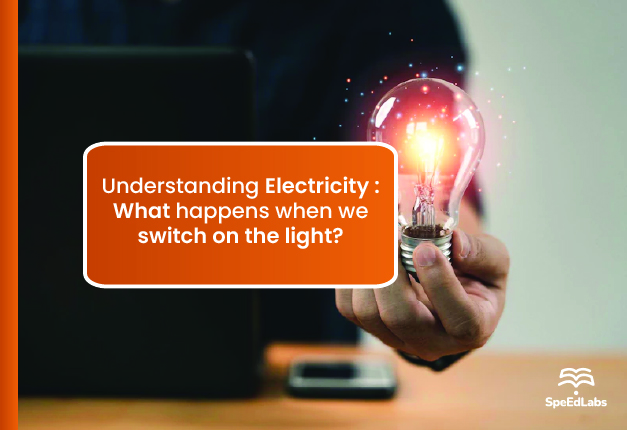In every aspect of our lives, electricity is a vital source of energy, and our reliance on it is only growing. Electricity powers appliances, heating, and lighting; soon, electric cars with electric motors will be seen more frequently worldwide.
We can generate electricity if we can rotate magnets around copper wire quickly enough in generators. If we make electricity our main source of energy for millennia, we will be able to produce clean energy thanks to wind turbines, hydroelectric power, steam-driven geothermal power plants, and other renewable energy sources.
WHAT HAPPENS WHEN WE SWITCH ON THE LIGHT?
When electricity (an electric current) is flowing through light, it is said to be “on.” A complete circuit is required for the flow of electricity. When a light is turned on by flipping a switch, the circuit that powers the light is closed. The circuit is being opened when the switch is flipped the other way to turn the light off. It may be confusing to associate closed circuits with on and open circuits with off; it may be easier to think of these as complete (=closed) and broken (=open). When the drawbridge is lowered (i.e., the path is complete), this is comparable to how one may cross a castle’s moat, but not when the bridge is raised (i.e., the path is broken).
ELECTRICITY AT A MICROSCOPIC LEVEL
An understanding of electricity at the microscopic level will help you to understand why a complete circuit is required. Charge carriers move when there is an electrical current. (These carriers are electrons in metals.) Electrical potential energy is the source of the driving force that is pushing these charge carriers. The energy of the charge carriers decreases as they move in the direction directed by the force. This can be compared to any other type of potential energy that propels a change, such as gravitational potential energy, which gives objects a reason to fall (or to move toward one another). A battery’s anode experiences a large-scale release of electrons while the cathode experiences a depletion. The anode is a region of high potential energy for electrons because charges of the same sign repel one another. This results in a large electric field and large energy. The cathode, which has fewer electrons and is subject to less repulsion, is where the electrons are driven.
The electrons cannot get to the cathode if the circuit is open (broken), though. Instead, they will gather in areas where their energy is reduced (e.g., as far down the circuit from the anode as possible). Current is flowing (i.e., charges are moving) while they are accumulating, so I suppose a light between the battery and the break could be on at this time. It is crucial to understand that every electron has an electric field and that the electric field gets stronger as more electrons are added. However, it will move in the opposite direction from that which is pushing the electrons through the circuit. These two fields eventually cancel each other out because their strengths are equal but their directions are opposite. No current is flowing at this time because the electrons are not being moved by anything. When the circuit is finished (closed), the electrons can continue to the cathode, losing more energy, causing the current to flow and the light to turn on.
EVERYTHING ABOUT ATOMS
Everything in the universe is made of atoms, which are the tiny building blocks of the universe. Each atom is only a millionth millimetre across (0.0000001 mm). A pinhead is thought to contain five million atoms, which gives you an idea of how tiny that is. A nucleus made up of protons and neutrons orbited by electrons exists inside each atom. These electrons reside in shells known as the inner and outer shells and are held in place by an electrical force. Protons and electrons are thought to have an equal number in the universe.
As we are accustomed to seeing on batteries, protons have a positive charge (+) and electrons have a negative charge (-). There is no difference in the electrical charge carried by protons and electrons. According to the famous song by Paula Abdul, opposites attract, so they are drawn to one another. The positive and negative charges were given names by Benjamin Franklin, who also discovered the electric charge.
Electrons are held in their orbit by an electrical force and move away from the nucleus at a constant distance. An atom is balanced in this state. While outer shell electrons can be moved, inner shell electrons are strongly drawn to protons. An outer shell electron can be pushed toward another atom if you exert enough force on it. These moving electrons produce electricity.
Through conductors like copper wire, which carry electrical current from a power source to the object we want to power, we can harness this movement of charged particles, or the electric charge. When we create a complete electrical circuit, the electrons do not move along the wire; instead, they bump into one another, transmitting the electrical charge. The electrical current that powers our lights, washing machines, and other devices come from this process.
CONSERVING ELECTRICITY
There are many different electrical appliances in every home, all with different wattages and voltages. They are all jam-packed with electrical parts, including transistors, capacitors, and resistors. What is the cost to you as a consumer and how much electricity do they use?
You can always reduce your costs by using a different electricity provider. They can also assist you in determining your preferred fuel source. Fossil fuel-powered facilities release harmful emissions into the atmosphere by producing carbon dioxide.
Examining an appliance’s power consumption in watts is the best way to determine how much electricity it is consuming.
Also published on Medium.
